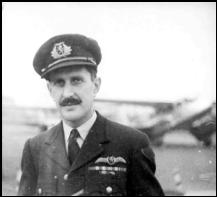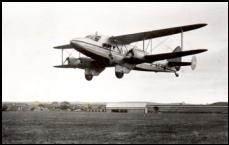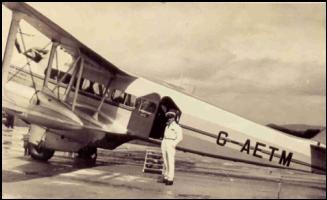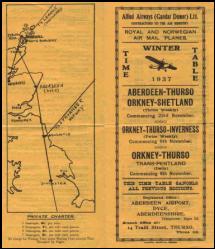The North Sea Air Mail Express Newcastle – Stavanger
By: Rob Mulder
For: www.europeanairlines.no
It has taken many years and numerous attempts to realise the opening of an air service between Norway and the United Kingdom. Both Norwegians and Englishmen have throughout the twenties and thirties of the last Century tried, but it was an Englishmen pursuing his dream that would follow in the footsteps of the Norwegian aviator Tryggve Gran and inaugurate an air service across the North Sea.
The first attempts from the Norwegian side
At the formation of Det Norske Luftfartrederi AS – DNL in 1918, the company suggested a number of air service that would form the foundation of the Norwegian network. Beside an air service to Göteborg (Gothenburg) and København (Copenhagen), DNL felt that another service should be established: A route from Stavanger to Aberdeen in Scotland. The reason why it should end in Aberdeen was simple: the shortest distance between Norway and Scotland was between these two cities. In Aberdeen there ought to be a connection to London. This would be the shortest route to London. But DNL never inaugurated any international air services, so a connection to London was still not possible.
In the spring of 1927 a trial route between Oslo, Kristiansand, Cuxhafen (Germany), Amsterdam (the Netherlands) and Harwich (UK) was scheduled. The modern Dornier Wal, N-25, that Roald Amundsen and his crew used on the Amundsen-Ellsworth North Pole Expedition, was placed at the disposal for this venture by the Norsk Luftseiladsforening (the forerunner of the Norwegian Aero Club). Three trial flights were made, but none of them with huge success. The English Government was not interested in this venture. If you in 1927 wanted to fly from Oslo to London you had to fly to København and continue via Hamburg and Amsterdam to London. By then you had to switch aircraft twice. But at that moment there was no alternative.
In September 1934 our famous Norwegian female pilot Gidsken Jakobsen entered the area and applied for a concession. She wanted to start a new airline company under the name of Bergen Aero AS and inaugurate a direct air service between Bergen and Newcastle. The service would be operated twice per week and would take three hours. She expected that especially Englishmen would benefit of this fast connection to the Norwegian mountains. They could get to their holiday resorts in no time. But she did not get a concession and also this initiative past away.
A Norway-lover tries it
So when it finally happened it was to be the Norway-lover Eric Leslie Gander Dower that took the initiative. He was correspondent for the English aviation magazine The Aeroplane, when Tryggve Gran in July 1914, just before his departure for the flight across the North Sea, met Gran. The trip from Curden Bay (Scotland) to Jæren (Norway) took 5 hours and 40 minutes. This was one of the longest sea air routes ever flown and it was the first time a landplane crossed the North Sea.
Jubilee and formation
 In 1934 at the 20th jubilee they met each other again. The same crossing was made by three Norwegian military Fokker-aircraft, where Tryggve Gran was one of the pilots. The Fokker-aircraft used Gandar Dower’s airport Dyce near Aberdeen. Meanwhile, Eric Leslie Gandar Dower had in January 1934 formed his own airline company called Aberdeen Airways Ltd and purchase an aeroplane of the type De Havilland DH.84 Dragon II (G-ACRH Aberdonian). Unfortunately it already crashed in July 13, just one week after delivery. In order to be able to realise his dreams he decided to increase the stock capital of his company to £ 20,000 and for that money he bought a Short S.16 Scion (G-ACUV) as replacement of his DH.84. The company inaugurated with this aircraft on September 10, 1934 its first regular air service between Aberdeen/Dyce and Glasgow. As pilot, Eric Leslie Gandar Dower had hired the ambitious Captain Eric Starling (see picture), who was to become one of the most popular pilots in Scotland and the Shetland Islands.
In 1934 at the 20th jubilee they met each other again. The same crossing was made by three Norwegian military Fokker-aircraft, where Tryggve Gran was one of the pilots. The Fokker-aircraft used Gandar Dower’s airport Dyce near Aberdeen. Meanwhile, Eric Leslie Gandar Dower had in January 1934 formed his own airline company called Aberdeen Airways Ltd and purchase an aeroplane of the type De Havilland DH.84 Dragon II (G-ACRH Aberdonian). Unfortunately it already crashed in July 13, just one week after delivery. In order to be able to realise his dreams he decided to increase the stock capital of his company to £ 20,000 and for that money he bought a Short S.16 Scion (G-ACUV) as replacement of his DH.84. The company inaugurated with this aircraft on September 10, 1934 its first regular air service between Aberdeen/Dyce and Glasgow. As pilot, Eric Leslie Gandar Dower had hired the ambitious Captain Eric Starling (see picture), who was to become one of the most popular pilots in Scotland and the Shetland Islands.
The company had not any success with this air route. Nearly no passengers were transported and already on October 24 the service was discontinued. In 1935 Aberdeen Airways Ltd started up flying between Dyce and Stromness (from May 27) and to Edinburgh (June 4), but latter city had to be dropped again due to lack of passengers. But the Stromness service was later prolonged to Thurso and included also St Margaret’s Hope in the Orkney Islands.
In 1936 Eric Leslie Gandar Dower travelled in his 10 hp Austin car to Norway to deliver personally his application for the concession of the air service across the North Sea. King Haakon VII of Norway allowed him an audience at his castle and this increased his love for Norway even more. He was now determined to open the air service between Aberdeen and Norway.
Allied Airways (Gandar Dower) Ltd “formed”
At the end of the year (November 17, 1936) Eric Leslie Gandar Dower changed the name of his company and from February 13, 1937 the official name Allied Airways (Gandar Dower) Ltd was adopted. The name change was made in order to give the company a more international image, Furthermore, Eric Leslie Gandar Dower wanted to separate the aviation company from his other companies. The stock capital had been increased to £ 40,000 in order to be able to purchase a new aircraft for his scheduled air service to Norway and to finance the venture.
Flying to Sola Airport in Norway
The delivery of the new aircraft, a De Havilland DH.86B Express, was delayed so it was no impossible to present the aircraft to the Norwegian public at the official opening of the Sola Airport near Stavanger on May 29, 1937. In stead the De Havilland DH.89 Dragon Rapide, G-ADDE was given the honour to be the first British civil aircraft to cross the North Sea in Tryggve Gran’s footsteps. Before his first flight across the North Sea the Dr Agnes Thomson, first GP in Aberdeen, handed Captain Starling a white feather (see picture). He departed on May 22 at 1.55 pm (GMT) and used 2 hours and 25 minutes for the crossing from Aberdeen/Dyce to Stavanger/Sola. Here the aircraft was also the first to be registered in the landing log of the airport as well.
Again the pilot was Captain Starling, the man that was destined to fly the air route during the summer. Furthermore, the crew consisted of Alec Milnes and Cecil Goodall. Among the passengers was of course Eric Leslie Gandar Dower. He travelled along to sort out the last details before the grand opening of the air service. He continue the following day to Oslo/Kjeller were he met the management of Det Norske Luftfartselskap A/S, Fred. Olsen & Bergenske – DNL. The national carrier of Norway was to be the handling agent in Norway and would prolong the service from Stavanger along the coast to Oslo and further to Stockholm. Captain Eric Starling had here the unique opportunity to fly together with DNL-pilot Finn Lambrechts in the Junkers Ju 52/3m with the registration LN-DAH on the air service Oslo – Stavanger – Kristiansand – Arendal – Oslo (on May 24). A new flight followed this time with Bernt Balchen in a Junkers Ju 52/3m, LN-DAF. He flew to Bergen and back to Oslo. On this flight Capt Starling acted as second officer.
On May 29 Capt Starling and crew returned with their passengers to Stavanger to participate in the opening of the Stavanger/Sola Airport. On the opening day the aircraft made a fly-past followed by a number of joy ride flights. On June 2, at 2.40 pm the De Havilland DH.89 Dragon Rapide, G-ADDE took off from Sola Airport and landed at Aberdeen/Dyce after exactly three flying hours.
Delivery of the new aircraft
 The aircraft that Eric Leslie Gandar Dower used during the grand opening of the Sola Airport was not at all suited for the Stavanger service. It had just two engines and no de-icing equipment. Therefore Allied Airways (Gandar Dower) Ltd ordered a new four-engine De Havilland DH.86B Express from the De Havilland factory at Hatfield.
The aircraft that Eric Leslie Gandar Dower used during the grand opening of the Sola Airport was not at all suited for the Stavanger service. It had just two engines and no de-icing equipment. Therefore Allied Airways (Gandar Dower) Ltd ordered a new four-engine De Havilland DH.86B Express from the De Havilland factory at Hatfield.
The aircraft had numerous modification compared with its predecessor the DH.86 and DH.86A. Among other the two so-called Zulu-shields at the back of he aircraft made it more stable and easier to fly. In the configuration of Allied Airways (Gandar Dower) Ltd it had a crew of three and carried a maximum of eight passengers.
On June 28, 1937 Captain Eric Starling took delivery of the aircraft at Hatfield Airport and after some pre-delivery flights the aircraft was accepted. On June 29 it was registered G-AETM (c/n 2353) and christened The Norseman. Once back in Aberdeen it made some joy ride flights where it carried no less than 48 guests.
The aircraft had two sets of radios, de-icing equipment, cabin heating and a toilet. The company composed a crew: Captain Starling as first officer, Alec Milnes as radio operator and Cecil Goodall as engineer. This crew carried out all flights made between Newcastle and Stavanger in 1937 and 1938.
The reason why Newcastle was chosen in favour of Aberdeen/Dyce was:
- Aberdeen/Dyce, Allied Airways (Gandar Dower) Ltd main base did not have any radio facilities. The reason for this was that the owner Eric Leslie Gandar Dower did not wanted any other airline companies to use his private owned airfield. This he would have to allow if this equipment was available.
- North Eastern Airways offered a connection from Newcastle to Edinburgh, Perth and Glasgow.
On July 5, one week before the official opening of the air service, the crew and the aircraft made a trial flight from Newcastle to Stavanger and further to København (Copenhagen, Denmark) and Göteborg (Gothenburg, Sweden). They returned to Stavanger and Newcastle on July 7. A representative from Standard Electric flew along to check the radios. Also on board was Mr Handcox, an assistant to Alec Milnes. The whole trip went without any problems.
1937 – The first year of the operation
 The big day came: July 12, 1937. Allied Airways (Gandar Dower) Ltd inaugurated the regular air service Newcastle – Stavanger. On this first trip Captain Starling carried the following passengers: Eric Leslie Gandar Dower, Ald. J Grantham (lord major of Newcastle, Mr Dalgleish and Mr Bissett (both directors in Allied Airways (Gandar Dower) Ltd). The aircraft took off from Newcastle/Wolsington at 11.10 am and encountered no problems on it way to Stavanger/Sola. Here it arrived exactly 3 hours later. Due to festivities in Newcastle the departure from Wolsington was delayed with 25 minutes. In England the service was known under the name of “North Sea Air Mail Express Newcastle – Stavanger”. In Stavanger the national carrier of Norway, DNL, offered a connection to Oslo and Stockholm (by respectively Junkers Ju 52/3m and Sikorsky S.43). From Oslo it was also possible to continue to Göteborg and København. In Newcastle there was, as mentioned before, a connection to and from Edinburgh, Perth and Glasgow. Arriving from Norway you could also connect with the train to London (departure 6.33 pm). Upon arrival at Stavanger on the day of the opening, the aircraft left for Newcastle again at 4.05 pm. The whole season the reliable De Havilland DH.86B Express, G-AETM was used.
The big day came: July 12, 1937. Allied Airways (Gandar Dower) Ltd inaugurated the regular air service Newcastle – Stavanger. On this first trip Captain Starling carried the following passengers: Eric Leslie Gandar Dower, Ald. J Grantham (lord major of Newcastle, Mr Dalgleish and Mr Bissett (both directors in Allied Airways (Gandar Dower) Ltd). The aircraft took off from Newcastle/Wolsington at 11.10 am and encountered no problems on it way to Stavanger/Sola. Here it arrived exactly 3 hours later. Due to festivities in Newcastle the departure from Wolsington was delayed with 25 minutes. In England the service was known under the name of “North Sea Air Mail Express Newcastle – Stavanger”. In Stavanger the national carrier of Norway, DNL, offered a connection to Oslo and Stockholm (by respectively Junkers Ju 52/3m and Sikorsky S.43). From Oslo it was also possible to continue to Göteborg and København. In Newcastle there was, as mentioned before, a connection to and from Edinburgh, Perth and Glasgow. Arriving from Norway you could also connect with the train to London (departure 6.33 pm). Upon arrival at Stavanger on the day of the opening, the aircraft left for Newcastle again at 4.05 pm. The whole season the reliable De Havilland DH.86B Express, G-AETM was used.
 The route was no success for the company, especially because of the competition of the Norwegian ferry companies. These companies threatened to boycott any travel agency that would sell tickets for the North Sea Air Mail Express Newcastle – Stavanger. Thus Allied Airways (Gandar Dower) Ltd could not obtain a sound financial basis for its air route. The concession from the Norwegians included the transportation of Norwegian air mail, but English air mail was never loaded on board the aircraft. The British Post did not see the importance of the route. Despite the fact that the concession was valid until December 31, it was decided to discontinue the air service on September 27. The results were appalling:
The route was no success for the company, especially because of the competition of the Norwegian ferry companies. These companies threatened to boycott any travel agency that would sell tickets for the North Sea Air Mail Express Newcastle – Stavanger. Thus Allied Airways (Gandar Dower) Ltd could not obtain a sound financial basis for its air route. The concession from the Norwegians included the transportation of Norwegian air mail, but English air mail was never loaded on board the aircraft. The British Post did not see the importance of the route. Despite the fact that the concession was valid until December 31, it was decided to discontinue the air service on September 27. The results were appalling:
July 1937 13 round trips
August 1937 20 round trips
September 1937 9 round trips
A total of 108 passengers were transported in July and August. Captain Eric Starling found it too depressing to make a note of the September-results! But there were some highlights: On August 20, Captain Starling only used 2 hours and 30 minutes for the trip Stavanger – Newcastle and on September 2 he used 2 hours and 24 minutes between Newcastle and Stavanger. He logged a total of 268 hours and 20 minutes on this air service.
1938 – Not much better
The Stavanger service was re-opened on April 16, 1938 with the same aircraft and the same crew. On the picture we can see Captain Eric Starling in the cockpit of his De Havilland DH.86B Express. For Captain Starling the flights were getting rather boring. Some times it nearly went “wrong”. Captain Starling told me the following story: “When we had reached the point of no return we checked the possibility to return to Newcastle in case of bad weather in Stavanger. Fog in Stavanger made that day the landing there impossible and I decided to return to Newcastle. We were at 1,500 feet when we flew above some fisherman’s ships. I landed smoothly at Wolsington. Well one week later one of my passengers asked if I could guarantee that she would come to Stavanger. I asked her why she asked and she replied that her farther was captain on a fisherman’s ship and had see me turn around last week! What a coincident!”
Neither 1938 brought any better results on the air service. Despite the positive attitude from the Norwegian government (Allied Airways (Gandar Dower) Ltd had its concession extended until December 31, 1941 and was also allowed to fly between Stavanger and Oslo, without carrying domestic passengers) Eric Leslie Gandar Dower had to make the difficult decision to discontinue the air service as from September 19, 1938.
During 1938 some milestones and events were achieved:
On May 2, 1938 the 100th crossing of the North Sea (according to the log of Captain Starling “with beautiful weather”)
On June 20, 1938 Problems with the inside port engine (the trip from Stavanger to Newcastle lasted 3 hours and 45 minutes)
On August 9, 1938 it was impossible to land at Newcastle due to fog and the aircraft landed on Aberdeen/Dyce in stead.
September 19, 1938 the final and 166th crossing of the North Sea.
The results for 1938 were again disappointing: Only 71 trips and 137 passengers, which gave an average of less than 2 passengers per flight!
Eric Leslie Gandar Dower would have liked to open the air service in 1939, but this was never done. In two years time he had lost £ 16,000 and since he did not receive any financial support from the British side he found it economically not right to restart in 1939. Even an official visit of the British Air Ministry to Stavanger in August 1938 could not convince the British of the necessity of the air service. It was not until 1973 before a British aircraft landed at Stavanger Sola Airport on a regular air service from Newcastle. It was Dan-Air that operated the air service. When the Scandinavian Airlines System opened its air service Stavanger – Newcastle Captain Eric Starling was guest of honour during the festivities. The man that laid the foundation of the route can be proud of his achievements.
This article is a translation of an article published by my in Norway. I would like to thank Captain Eric Starling for the photographs and information supplied. Also I thank John Stroud and Peter V Glegg for their extensive help in compelling information for this article. The timetable published is from the collection of Michael Dawes.
